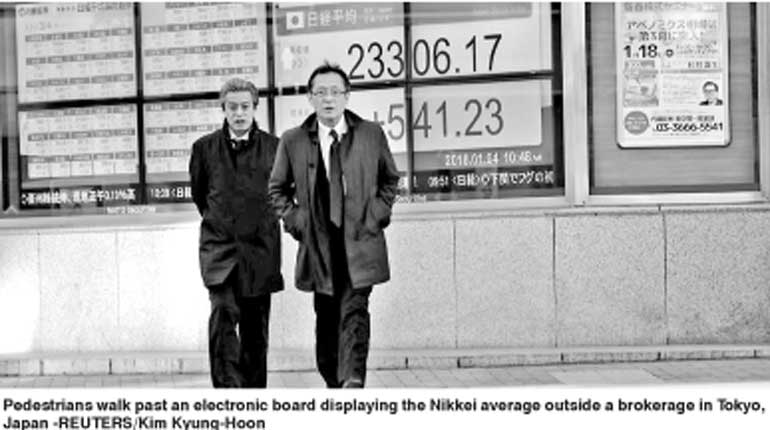Tuesday Mar 04, 2025
Tuesday Mar 04, 2025
Saturday, 27 January 2018 00:55 - - {{hitsCtrl.values.hits}}

TOKYO (Reuters): Asian stocks came off record highs on Friday but were still poised to end the week with strong gains, while the battered dollar won back some ground after President Donald Trump said he wanted a strong US currency.
MSCI’s broadest index of Asia-Pacific shares outside Japan was effectively flat at 609.50 after reaching a record intraday high of 611 on Thursday, capped after Wall Street shares lost momentum overnight.
MSCI’s Asia-Pacific index was still poised to rise about 1.8% on the week and headed for its seventh straight week of gains.
World equity markets have rallied over the past year, buoyed by a synchronised uptick in global economic growth in a boon to corporate profits and stock valuations.
South Korea’s KOSPI was flat and the dollar’s bounce against the yen lifted Japanese stocks, with the Nikkei rising 0.15%. Australian markets were closed for a public holiday.
The Dow and S&P 500 ended at their highest closing levels ever on Thursday although Wall Street relinquished bigger intraday gains after President Trump’s strong dollar comments.
Trump said on Thursday he ultimately wants the dollar to be strong, contradicting comments made by Treasury Secretary Steven Mnuchin one day earlier.
The dollar index against a basket of six major currencies was at 89.221. It had sunk to a three-year low of 88.438 on Thursday after Mnuchin said he welcomed a weaker greenback, which the markets initially took as Washington’s departure from its strong dollar policy.
“Trump did say he wanted a stronger dollar, but at the same time made no intention of changing his stance towards pursuing US interest through trade policies,” said Junichi Ishikawa, senior FX strategist at IG Securities in Tokyo.
“Comments from US top officials regarding the dollar are likely to continue lacking consistency going forward,” he said.
Even if the Trump administration does push for a weaker dollar, the current US monetary policy trend was expected to complicate the agenda.
“Help from the Federal Reserve would be needed to weaken the dollar. But right now, the Fed is in midst of raising interest rates and this is not conducive to a weaker currency,” said Makoto Noji, senior strategist at SMBC Nikko Securities in Tokyo.
The Fed conducted three rate hikes in 2017 and is expected to tighten as many as three more times in 2018.
The euro was 0.1% higher at $1.2417 but still some distance from $1.2538, its highest since December 2014 scaled on Thursday.
The common currency had soared to the fresh three-year high on Thursday after European Central Bank President Mario Draghi said economic data pointed to “solid and broad” growth with inflation likely to rise in the medium term from subdued levels.
Draghi also said the recent surge in the euro was a source of uncertainty, although this had little impact on the currency as some market participants had expected the ECB chief to use stronger language.
The dollar was flat at 109.420 yen, rebounding from a four-month low of 108.500 set the previous day.
The pound was 0.3% higher at $1.4175 following its ascent to a 1-1/2-year high of $1.4346 the previous day.
The Australian dollar climbed 0.3% to $0.8049, edging back towards a four-month peak of set $0.8119 overnight.
The dollar’s bounce weighed on commodity prices, which had risen to multi-year peaks earlier this week. A stronger greenback tends to weigh on commodities as is seen making it more expensive for non-US buyers of dollar-denominated products.
US crude futures were 0.2% lower at $65.39 per barrel after reaching $66.66 on Thursday, highest since December 2014.
Spot gold was a shade higher at $1,350.80 per ounce after sliding 0.8% overnight. It set $1,366.06 earlier on Thursday, its highest since August 2016.
Discover Kapruka, the leading online shopping platform in Sri Lanka, where you can conveniently send Gifts and Flowers to your loved ones for any event including Valentine ’s Day. Explore a wide range of popular Shopping Categories on Kapruka, including Toys, Groceries, Electronics, Birthday Cakes, Fruits, Chocolates, Flower Bouquets, Clothing, Watches, Lingerie, Gift Sets and Jewellery. Also if you’re interested in selling with Kapruka, Partner Central by Kapruka is the best solution to start with. Moreover, through Kapruka Global Shop, you can also enjoy the convenience of purchasing products from renowned platforms like Amazon and eBay and have them delivered to Sri Lanka.
Discover Kapruka, the leading online shopping platform in Sri Lanka, where you can conveniently send Gifts and Flowers to your loved ones for any event including Valentine ’s Day. Explore a wide range of popular Shopping Categories on Kapruka, including Toys, Groceries, Electronics, Birthday Cakes, Fruits, Chocolates, Flower Bouquets, Clothing, Watches, Lingerie, Gift Sets and Jewellery. Also if you’re interested in selling with Kapruka, Partner Central by Kapruka is the best solution to start with. Moreover, through Kapruka Global Shop, you can also enjoy the convenience of purchasing products from renowned platforms like Amazon and eBay and have them delivered to Sri Lanka.